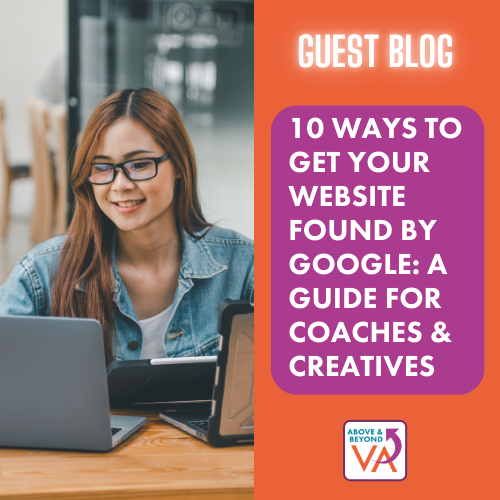By Uta Demontis
Having a beautifully designed website is essential, but it’s only half the battle. To attract your ideal audience – whether you’re a coach looking to help clients transform their lives or a creative showcasing your portfolio – you need to make sure your website gets found by Google.
With the increasing role of AI in search, Google’s algorithms are smarter than ever, focusing on user intent and high-quality, relevant content. This guide will help you navigate these changes and set your website up for SEO success.
1. Start with Google Search Console
Google Search Console is a free tool that acts as a bridge between your website and Google. For coaches and creatives, it’s essential to track how well your site performs in search results.
How to Use It:
- Coaches: Submit a sitemap that includes all your Work With Me pages and blog posts to ensure they’re indexed.
- Creatives: Make sure your portfolio pages are included in the sitemap, so Google can index your work.
Example: A life coach might have a blog post titled “5 Steps to Overcoming Impostor Syndrome” and ensure its indexed and performing well using this tool.
2. Choose keywords that speak to your audience
Keywords help Google match your website to what your audience is searching for. Instead of guessing, use tools like Google Keyword Planner or Ubersuggest to find terms relevant to your niche.
Examples:
- For Coaches: Use keywords like “stress management coach London,” “mindset coaching for entrepreneurs,” or “how to set healthy boundaries.”
- For Creatives: Try “wedding photographer Hampshire,” “custom logo design for small businesses,” or “abstract watercolour prints for sale.”
Incorporate these naturally into your page titles, headings, meta descriptions and blog content.
3. Create content that answers questions
Google increasingly uses AI to prioritise content that matches user intent – what people are really looking for when they type a query. Think about the questions your ideal audience might ask and provide detailed, thoughtful answers.
Examples:
- Coaches: Write a blog like “What to Expect in Your First Life Coaching Session” or create a free resource like a “Mindfulness Guide for Busy Professionals.”
- Creatives: Share posts such as “How to Choose the Perfect Colour Palette for Your Brand” or “Behind the Scenes of My Latest Branding Photoshoot.”
This type of content not only builds trust but also signals to Google that your site provides value.
4. Optimise for mobile
Mobile-first indexing means that Google prioritises evaluating the mobile version of your site when determining its ranking. For coaches and creatives, having a seamless mobile experience is non-negotiable.
Quick Fixes:
- Use responsive design to ensure your portfolio or coaching pages look great on smaller screens.
- Simplify navigation to make it easy for users to book a call or view your work.
Example: A logo designer could use large, clickable thumbnails to showcase portfolio pieces, while a coach might highlight a clear “Book a Free Discovery Call” button.
5. Leverage AI tools to boost your SEO strategy
AI is revolutionising the way search engines operate and reshaping our approach to SEO. Tools like ChatGPT can help generate ideas for content or refine your copy, while Google’s AI-driven features prioritise user-friendly, authoritative content.
How AI Impacts Search:
- Coaches: With AI-powered search, queries like “best life coach near me” might yield a list of coaches with clear, engaging service descriptions. Ensure your site communicates your expertise and includes testimonials.
- Creatives: AI often highlights visually rich content. Use high-quality images of your work and optimise them with descriptive file names and alt text, e.g., “custom-logo-design-for-small-businesses.jpg.”
6. Hire a professional copywriter for human-centred content
While AI tools can assist with brainstorming ideas, Google continues to prioritise high-quality, human-written content that resonates with your audience. Collaborating with a professional copywriter (Note from Caroline: thanks for the shout out Uta) ensures your content is not only well-written but also tailored to your ideal clients’ needs and aligned with your brand voice.
Why It Matters:
- For Coaches: A skilled copywriter can craft compelling coaching pages and blog posts that build trust, showcase your expertise and encourage clients to take the next step.
- For Creatives: A copywriter can help you tell the story behind your work, write engaging descriptions for your portfolio and create content that speaks to your artistic vision.
Google’s algorithms are designed to detect content that is authentic, valuable and user focused. High-quality, human-written content not only performs better in search rankings but also fosters meaningful connections with your audience – something AI-generated text can rarely achieve.
Example: Instead of generic service descriptions, a copywriter can transform your website into a storytelling platform that captures your unique approach and speaks directly to the clients you want to attract.
7. Speed up your site
No one likes waiting for a slow website to load – least of all Google. Speed affects rankings, so ensure your site is quick and responsive.
Tips:
- Compress images without losing quality.
- Use a lightweight WordPress theme if you’re using WordPress.
- Optimise video content by hosting it on platforms like Vimeo or YouTube instead of embedding large files.
Example: A photographer showcasing high-resolution images can use image compression tools to keep loading times fast while preserving visual impact.
8. Get backlinks by sharing your expertise
Backlinks – links from other websites to yours – play a vital role in SEO. They signal authority to Google and can drive traffic from relevant sources.
How to Build Backlinks:
- Coaches: Pitch guest posts to niche blogs like “The Wellness Coach Blog” and link back to your website.
- Creatives: Submit your work to online design directories or collaborate with bloggers to showcase your portfolio.
Example: A coach who writes a guest post titled “The Power of Visualisation in Achieving Goals” on a wellness blog not only builds authority but attracts potential clients.
9. Harness local SEO to attract nearby clients
If your business serves a local audience, optimise for local search. Create or update your Google Business Profile with accurate information and encourage clients to leave reviews.
Examples:
- Coaches: Add terms like “Canary Wharf career coach” to your coaching pages.
- Creatives: Ensure your portfolio site includes “wedding photographer based in Kent.”
10. Adapt to Google’s AI-generated search answers
Google’s AI-powered features, like Search Generative Experience (SGE), are reshaping how search results are displayed. These AI-generated summaries are what you see at the top of the page. Instead of clicking on a website to get answers, the answers are provided directly within Google. To stay relevant, ensure your content is optimised to be included in these featured snippets.
How to Adapt:
- Structure your content with clear headings and concise answers to common questions.
- Use bullet points, numbered lists and tables to make information easily scannable.
- Focus on producing authoritative, well-researched content that Google recognises as a trustworthy source.
By creating content that aligns with Google’s emphasis on quick, accurate answers, you can increase your visibility even in AI-enhanced search results.
Final Thoughts
Getting found on Google takes effort, but it’s an investment in your business’s long-term success. For coaches and creatives, SEO is about more than rankings – it’s about connecting with the people who need what you offer.
About the Author

Uta Demontis is a web designer specialising in creating stunning and effective WordPress websites for coaches, solopreneurs and small businesses.
She designs websites that are not only visually appealing but also strategically crafted to serve as powerful marketing tools that attract clients and drive business growth.

